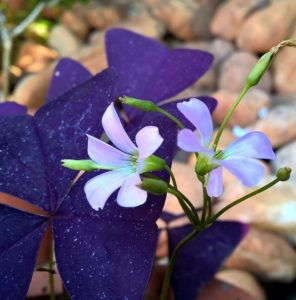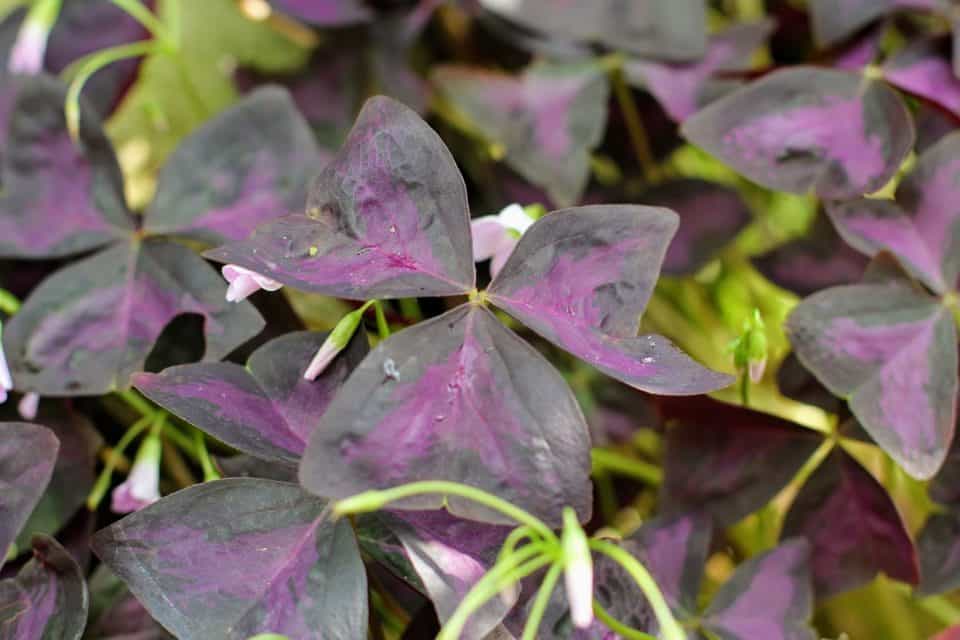Some links in the post are affiliate links and I get a commission from purchases made through some links found in the post.
Who does not want an easy-to-care-for plant adorning their home?
As people brighten up their spaces and try to get more air circulation going, it’s easy to see why beginner plants have become common.
Even so, you can still face problems when growing oxalis, what other gardeners term as the simplest plants to care for.
Does this describe what you’re going through with your oxalis? Do you want to know what’s ailing or killing your plant? You’ve come to the right place!
This article will cover the main problems you can face with your oxalis, how to care for it and what you can do when faced with any of these challenges. Let’s get started:
What are the Common Oxalis Problems?
 If your oxalis plant does not get the proper care it deserves, it will communicate this to you by exhibiting signs that all is not well.
If your oxalis plant does not get the proper care it deserves, it will communicate this to you by exhibiting signs that all is not well.
The common oxalis problems are:
- Yellowing leaves
- Crispy leaves
- Leaves falling off
- Mold on the soil
- Browning leaf tips
- Stunted growth
- Reduced leaf production or growth rate
Have you noticed any of these signs in your plants? Let’s look at what could be affecting your plant.
Why is my Oxalis Drooping?
Given their dormancy periods; it’s pretty easy to see oxalis plants going through drooping phases in their lives as they approach the end of their growing season.
If this is the reason for the change, you just need to ensure the plant has what it needs, and it will bounce back once the dormancy ends.
Hold back on the water and wait until the leaves die back, leaving watering at a minimum.
Once the plant starts showing signs of new growth, you can start increasing the watering frequency, and the plant should be fine.
However, if dormancy is not the reason, the droop likely owes to a lack of water, and you may want to look into whether the plant is getting as much moisture as it needs.
In some cases, though, the droop results from a lack of adequate lighting, pest attacks, and a poor potting mix.
More often than not, drooping leaves are often yellow or brown, signalling that the plant could die if you don’t act fast. So, what should you do?
First, we need to assess all the possible causes of drooping and think of what we can do to prevent this in the future.
Poor Watering Techniques
It might seem off, but most plants suffer from either getting too much water or too little water.
Striking a balance between the two often escapes gardeners and could be the reason why your plant is not doing so well.
Generally, your oxalis should do well in wet soil and usually prefers to be in such moist conditions. However, you should not drown the plant.
Instead, you should wait until the top two layers of the soil feel dry before watering the plant.
Allow the soil to dry out between watering but never too dry that the soil lacks moisture to carry nutrients to the plant.
It takes time to perfect this balance and, in the meantime, you can always rely on a moisture gauge.
If you need help watering your plant, try using this automatic drip irrigation kit.
Poor Lighting
How much light are you allowing your plant to access? It’s easy to stash this beautiful plant in the corner, forgotten and alone, and expect it to bloom like it would when in the wild.
However, this only hurts its growth, and you will notice that it not only droops but also stunts in growth. If you don’t fix the problems fast, you can even end up killing the oxalis plant.
The best thing to do is place the plant in indirect sunlight, such as near a window, ensuring you have blinds or sheers in place to protect the leaves from direct sunlight.
Be warned, though, that too much light would be just as bad as too little light and can even cause burning.
If your plant is struggling due to light, trying using this to help regulate the lighting.
Poor Potting Mix
Have you ever considered that your choice of potting mix can also be to blame for drooping leaves? Think about it.
You might have the watering down to an art, an ideal location, and everything else in place, but the plant still suffers from poor health.
In this case, you might need to question the potting mix in two aspects: its drainage and its nutrient profile.
Let’s start with the first one. It could be that the soil drains so fast that the plant barely gets to soak up enough water via the roots.
It would mean that you would need to water more frequently, and even then, the water would still not be of much use to the plant.
The second aspect refers to how many nutrients the soil has and whether its pH level is ideal.
Anything from 6.1 to 6.5 is great, and you want to ensure that you maintain this range.
Also, the plant should have access to a wide range of nutrients. If you feel the soil lacks nutrients, use a mild fertilizer to boost the nutrient profile.
Please note that you should not use a ‘ready to pour’ fertilizer in your soil before ensuring the soil is well saturated, as this can burn the roots.
Sometimes, the damage can be severe enough to kill the plant. Using half the recommended dosage of the fertilizer can save you from this headache.
Alternatively, make a mild homemade fertilizer.
Pests
You may need to keep an eye out for any pests that could be wreaking havoc on the plant’s leaves.
Save this for last as other factors often take precedence over pest infestations.
Some of the common pests for oxalis plants include vine weevils, blackflies, spider mites, mealybugs, root mealybugs, thrips, and aphids.
They often locate themselves on the underside of leaves, but vine weevils and root mealybugs often dig into the soil.
If you’ve already noticed an infestation, buy a suitable insecticide or make one from the ingredients in your kitchen.
If pests are yet to attack your plant, adopt some proactive measures, such as spraying your plant with a mixture of water and a mild detergent every month.
If you are enjoying this article, check out our article on how do you revive an aspidistra?
Why is Oxalis Drooping After Repotting?
 Shock. That’s right. Your oxalis plant may have gone into shock after its last repotting, especially if you have done so right before the blooming season begins, which could be why it is drooping.
Shock. That’s right. Your oxalis plant may have gone into shock after its last repotting, especially if you have done so right before the blooming season begins, which could be why it is drooping.
Also, if you decide to switch things up and use a different potting mix for the next pot, the plant may take time to adapt to the new environment.
The good news is that your plant will hardly require repotting, and you will only face this every few years.
However, when you have a dropping plant, getting it to look healthy can be quite a hassle, and sometimes, you can lose the battle.
What can you do? First, you need to watch your timing and avoid repotting the plant right before it starts to bloom.
Doing so will put it under a lot of stress because it tends to be highly sensitive at this point.
Unless you have to repot the plant, save the repotting for way after spring.
Secondly, you should try and match the original potting conditions as much as you can.
Note the soil mixture, the moisture content, the location, and everything else you had in the first pot, and match this to your new pot.
Why is my Oxalis Leggy?
Sometimes, your plant may exhibit signs of legginess or sparseness. It’s highly likely trying to signal it needs more light.
You may notice that the stem may also be growing towards the light, thus appearing bendy.
An easy way to solve this is by moving the plant to a location near more light, such as a few meters within an eastern-facing window, to ensure the plant gets enough light to recover from the phototropism.
Please note that you should choose a location with enough lighting to account for the days where it didn’t have enough light. That’s all you need to get it back on the right track.
Why is my Oxalis Yellowing?
The good news is that your plant’s leaves are probably going through a natural process that has triggered the yellowing.
In most cases, you should not have reasons for concerns. Let’s look at some interesting reasons:
Dormancy
Once your plant goes into dormancy, which is around late spring or the start of summer, its leaves yellow and die, which is a natural process in its life.
When you notice this, ensure that you cut back on watering and do not fertilize the soil.
Instead, you should wait for the plant to show signs of new life before gradually resuming your watering practices.
You might find that your plant may not undergo this process, and you might not have to change a thing.
But if it does, move it to a location with less light and with much cooler temperatures to allow it to rest.
Aging
Aging is another natural part of the plant’s life, and it will start yellowing as it moves closer to dying.
There’s not much you can do to revive a dying plant other than to give it some good care and ensure it’s in good health.
Sometimes, you may confuse dormancy with death. Ensure you understand what’s happening to your plant to avoid neglecting it in its hour of need.
Overwatering
Here is a familiar problem gardeners face with their plants: giving them too much love in the form of water.
Are you guilty? As much as this plant does well in moist conditions, its roots can drown if you grow the plant in soggy soil.
Only water the plant when the top two inches of the soil are dry.
Otherwise, you will fill the air pockets, deny the plant of air and encourage root rot, leading to the death of the plant.
If you need help watering your plant, try using this automatic drip irrigation kit.
Other Oxalis Problems
Now that we have covered the most common problems that face oxalis gardeners, let’s look at other related issues and how you can solve them using the solutions we listed above.
Why is my Oxalis Plant Turning Brown?
Common causes include lack of water, pest attacks, and plant dormancy. Can you think of how you can solve this based on the solutions we covered earlier?
Why are my Oxalis Plant’s Leaves Turning Crispy and Falling Off?
Underwatering is the likely culprit.
Why is my Soil Turning Mouldy?
Interestingly, this can result from overwatering or underwatering the plant.
Figure out what you’re doing wrong and fix it. Additionally, look at whether the plant is getting enough light.
Why are my Oxalis Plant’s Leaves Getting Brown Tips?
Insufficient humidity can cause browning accompanied by some yellowing.
While it may not kill the plant, it ruins its look. You can try misting the plant to increase the humidity.
Why is my Oxalis Plant Experiencing Slowed Growth?
You may be giving it inadequate water, poor lighting, or both.
However, your plant may also be rootbound, and if this is the case, you will need to repot it the right way. Again, keep timing and potting conditions in mind.
Why is my Oxalis Plant Gradually Losing Leaves?
You could have embraced poor watering techniques, or the plant may be going into dormancy.
Sometimes, poor lighting can also be a problem, and you may have to move the plant to a better-lit area.
Why are my Oxalis Plant’s Leaves Turning Pink, Green, or Red?
It’s normal- As the plant moves from one phase to the other, the leaf color changes. You can pluck out the leaves or wait for them to fall off.
How to Revive Your Dying Oxalis Plant
 Finally, let’s look at how you can revive your dying plant. Let’s suppose your plant looks like it’s about to die, and you have tried everything, but nothing seems to work.
Finally, let’s look at how you can revive your dying plant. Let’s suppose your plant looks like it’s about to die, and you have tried everything, but nothing seems to work.
Try this instead. Move the plant to a cool location and reduce your watering frequency. Do not fertilize it or disturb it for a while; and instead, allow it room to rest.
If its soil looks compacted, you can try repotting it (considering the time and the new potting conditions) and allow it to sit for a while.
Over time, your oxalis should look much healthier, making it easy for you to resume the proper care practices.
Hopefully we have helped you solve you oxalis problems. Happy Gardening!
Before you go, here are some more related articles I encourage you to read below to help solve more of your gardening issues:
How to solve anthurium leaf problems.
What are the Common Problems With a Pilea
10 Most Common Fatsia Japonica Problems
Common Problems with Hydrangeas


